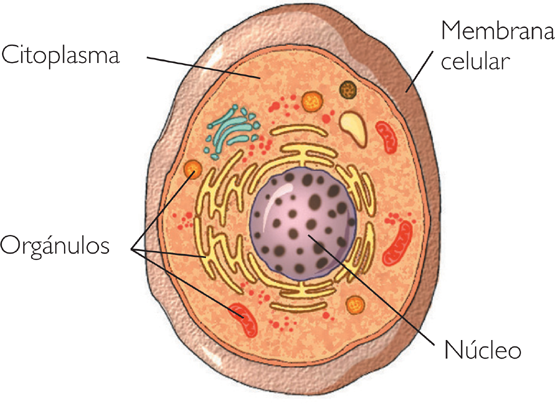The word protoplasm is derived from the Greek word “protos” which means “first” and “plasma”, which means “things formed”.Protoplasm is considered as the physical basis of life. The protoplasm of a cell consists of nucleus, cell membrane and cytoplasm. Therefore, the cytoplasm is a part of the protoplasm of a cell. The protoplasm is surrounded by a plasma membrane or cell membrane on all sides, while the cytoplasm is the substance that surrounds the nucleus inside a cell.

Each of the 75 trillion cells in the human being is a living structure that can survive indefinitely and, in most instances. can even reproduce itself. provided its surrounding fluids contain appropriate nutrients. To understand the function of organs and other structures of the body, it is essential that we first understand the basic organization of the cell and the functions of its component parts.
The different substances that make up the cell are collectively called protoplasm. Protoplasm is composed mainly of five basic substances: water, electrolytes, proteins, lipids, and carbohydrates.
Substances of Protoplasm In Humans
Water.
The principal fluid medium of the cell is water, which is present in a concentration of between 70 and 85 per cent. Many cellular chemicals are dissolved in the water, while others are suspended in small particulate form. Chemical reactions take place among the dissolved chemicals or at the surface boundaries between the suspended particles and the water. The fluid nature of water allows both the dissolved and suspended substances to diffuse or flow to different parts of the cell. thereby providing transport of the substances from one part of the cell to another.
Electrolytes.
The most important electrolytes in the cell are potassium/’l, magnesium, phosphate. sulfite, bicarbonate. and small quantities of sodium, chloride, and calcium.
The electrolytes are dissolved in the cell water, and they provide inorganic chemicals for cellular reactions. Also, they are necessary for operation of some of the cellular control mechanisms. For instance. electrolytes acting at the cell membrane allow transmission of electrochemical impulses in nerve and muscle fibers, and the intracellular electrolytes determine the activity of different enzymatically catalyzed reactions that are necessary for cellular metabolism.
Proteins.
Next to water. the most abundant substance in most cells is proteins. which normally constitute 10 to per cent of the cell mass. These can be divided into two different types, structural proteins and globular proteins that are mainly enzymes.
To get an idea of what is meant by structural proteins. one needs only to note that leather is composed principally of structural proteins. and that hair is almost entirely a structural protein. Proteins of this type are present in the cell in the form of long thin filaments that themselves are polymers of many protein molecules. The most prominent use of such intracellular filaments is to provide the contractile mechanism of all muscles. However. filaments are also organized into micro- tubules that provide the structures of such organelles as cilia and the mitotic spindles of misusing cells.
Special types of proteins are present in different palls of the cell. Of particular importance are the present both in the nucleus and in the cytoplasm. The nucleoproteins of the nucleus contain decl.vvri/»onucleic acid which con• stitutes the genes. and these control the overall function of the cell as well as the transmission of hereditary characteristics from cell to cell.
Lipids.
Lipids are several different types Of substances that are grouped together because of their common property of being soluble in fat solvents. The most important lipids in most cells are phospholipids and which consti- tute about 2 per cent of the total cell mass. These are constituents or the different membranes such as the cell membrane. the nuclear membrane. and the membranes lining intracytoplasmic organalies e.g., the endoplasmic reticulum and the mitochondria. The special importance otphospholipid and cholesterol in the cell is that they are either insoluble or only partially soluble in water.
carbohydrates.
In general. carbohydrates Carbohydrates have very little structural function in the cell except as part or glycoprotein molecules. However, carhohvdvate. in the fortn of glucose. is always present in the surround, ing extracellular fluid so that readily available to the cell, A small carbohydrate is Hl”ount usually stored in the cells in the torm 01 “Cen, which is an insoluble polymer of glucose and can be used rapidly to supply the cells energy needs.
Organic Substances of Protoplasm
Carbohydrates : Important source of fuel for living cells .
Store energy (primary source). Constitute cell walls. Main sugar transporter ( sucrose )
Lipids : Substances insoluble in water and soluble in organic solvents .
Energy reserve. Thermal insulation . Cell membrane formation . Protection of organs and structures
Proteins : Organic molecules of different sizes formed by amino acids .
Structural (protection) nails and hair. Hormone ( hormones ) Insulin . (Accelerates decomposition of foods by enzymes ). Transportation ( oxygen transport ).
Enzymes : Composed of proteins that increase the speed of a chemical reaction biological catalyst.
